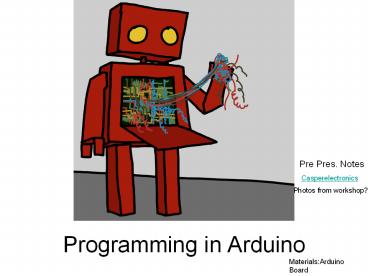Programming in Arduino - PowerPoint PPT Presentation
Title:
Programming in Arduino
Description:
Libraries Extend the capabilities of Arduino IDE Offer simpiler ways of controlling hardware they are ... Pseudocode Translation void loop ... – PowerPoint PPT presentation
Number of Views:1451
Avg rating:3.0/5.0
Title: Programming in Arduino
1
Programming in Arduino
Pre Pres. Notes
Casperelectronics
Photos from workshop?
MaterialsArduino Board
2
- Arduino.cc has the IDE programming software for
free download
3
Arduino Sketch
- Arduino files are called sketches.
- Arduino sketches must be compiled in the IDE
before being downloaded to the Arduino board.
4
Program Structure
- Two required functions in an Arduino sketch,
setup() and loop(). - setup() The function is called when your program
starts. Use it to initialize your variables, pin
modes, start using libraries, etc. The setup
function will only run once, after each powerup
or reset of the Arduino board. - Loop() After creating a setup() function, which
initializes and sets the initial values, the
loop() function does precisely what its name
suggests, and loops consecutively, allowing your
program to change and respond. Use it to actively
control the Arduino board.
5
What does void mean
- The void keyword is used only in function
declarations. It indicates that the function is
expected to return no information to the function
from which it was called.
6
Libraries
- Extend the capabilities of Arduino IDE
- Offer simpiler ways of controlling hardware they
are written for. - Advanced. will talk about later.
7
Variables
- Let you store a value.
- Must declare variables and tell computer what
kind of value to expect. - Int- number between -32,768 to
32,767 - Byte- 0 -255
- char- type character
- and more
8
Int variable
- int- an integer is a whole number (1,2,3,25)
- are your primary datatype for number storage, and
store a 2 byte value (take 2 bytes of memory).
This yields a range of -32,768 to 32,767 - example
- int ledpin 13 // sets the variable named
ledpin to 13
9
Char variable
- char- A data type that takes up 1 byte of memory
that stores a character value. - Both of these are equivalent and refer to the
letter A - char myChar 'A'
- char myChar 65 in ASCII
10
(No Transcript)
11
Byte variable
- Byte- an integer between 0 and 255 (byte uses
less memory, only 1 byte) - Made up of 8 bits.
Example in binary 00000001, 00000011
12
Binary Numbering (how computers count)
- If computers only know 1 and 0 how do they form
complex operations? - 128 64 32 16 8 4 2 1
- 00000001 1
- 00000010 2
- 00000011 3
- 00000100 4
13
Programming- Functions
- Segmenting code into functions allows a
programmer to create modular pieces of code that
perform a defined task and then return to the
area of code from which the function was
"called". - Existing Functions- commands Arduino
automatically understands - Custom Functions -The typical case for creating a
function is when one needs to perform the same
action multiple times in a program.
14
Example FunctionspinMode(), digitalWrite(), and
delay()
- The pinMode() function configures a pin as either
an input or an output. - pinMode(ledPin, OUTPUT) // sets
the digital pin as output - The digitalWrite() function outputs a value HIGH
or LOW on a pin. For example, the line - digitalWrite(ledPin, HIGH) //sets pin
high - The delay() causes the Arduino to wait for the
specified number of milliseconds before
continuing on to the next line. There are 1000
milliseconds in a second, so the line - delay(1000) // creates a delay of
one second.
15
Pseudocode Blink an Led
-
English - I want an led to blink, on for a second and off
for a second forever. -
Pseudocode - Turn led on
- wait
- Turn led off
- Loop again
16
Pseudocode Translation
- void loop() // run over and
over again - digitalWrite(ledPin, HIGH) // sets the LED
on - delay(1000) // waits for a
second - digitalWrite(ledPin, LOW) // sets the LED
off - delay(1000) // waits for a
second
17
Blink an Led(w/o comments)
- int ledPin 13
- void setup()
- pinMode(ledPin, OUTPUT)
- void loop()
- digitalWrite(ledPin, HIGH)
- delay(1000)
- digitalWrite(ledPin, LOW)
- delay(1000)
18
Blink an Led
- int ledPin 13 // LED connected
to digital pin 13 - void setup() // run once, when
the sketch starts - pinMode(ledPin, OUTPUT) // sets the
digital pin as output - void loop() // run over and
over again - digitalWrite(ledPin, HIGH) // sets the LED
on - delay(1000) // waits for a
second - digitalWrite(ledPin, LOW) // sets the LED
off - delay(1000) // waits for a
second
19
- Demo Programming board
20
HW Bring in a video or webpage link that is
related to Physical Computing that you think is
interesting and be prepared to talk about it in
class.































